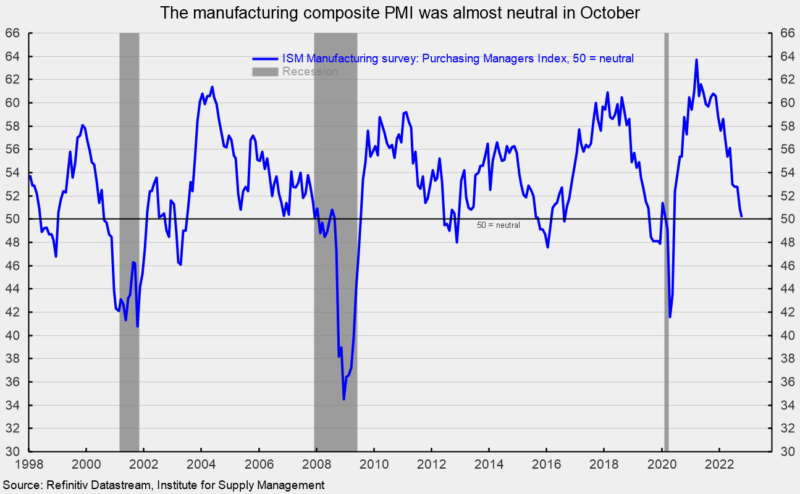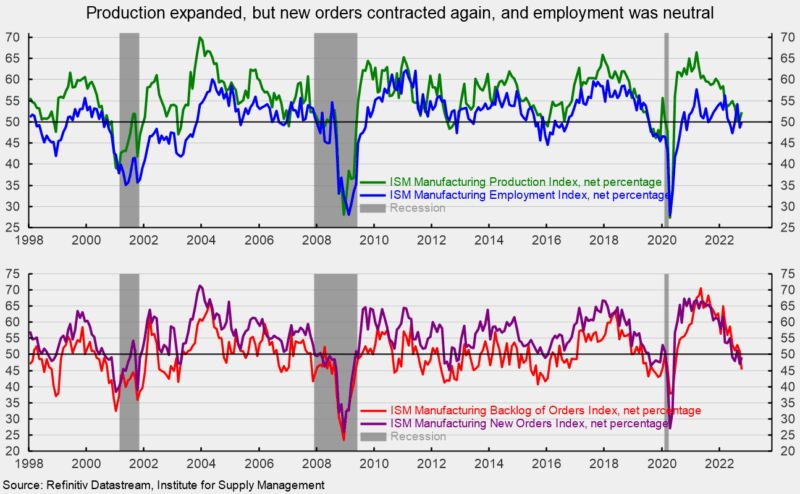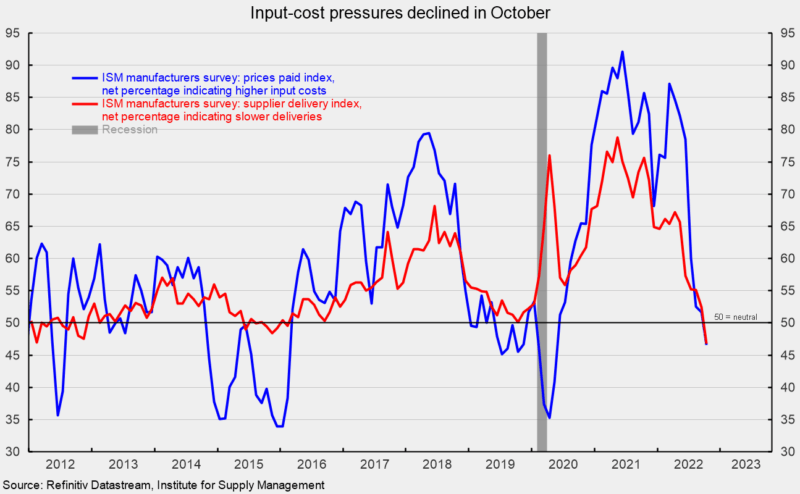October Manufacturing-Sector Survey Suggests Continued Weakening and Declining Price Pressures
The Institute for Supply Management’s Manufacturing Purchasing Managers’ Index fell to 50.2 percent in October, slightly above the neutral 50 level. October is the 29th consecutive reading above fifty. Still, the level is down sharply from the March 2021 peak, suggesting the manufacturing sector was essentially unchanged for the month (see the first chart).
Several key component indexes suggest weakening in October, including the prices-paid index and the supplier deliveries index, which are down from extreme levels. According to the report, “The U.S. manufacturing sector continues to expand, but at the lowest rate since the coronavirus pandemic recovery began.”
The Production Index registered a 52.3 percent result in October, rising 1.7 points from September (see the top of the second chart). The index has been above 50 for 29 months but below its 25-year average of 55.4 percent.
The Employment Index came in exactly at the neutral 50 threshold. The reading suggests payrolls were essentially unchanged in the manufacturing sector in October (see the top of the second chart). The report states, “Business Survey Committee panelists’ companies are continuing to manage head counts through hiring freezes and attrition to lower levels, with medium- and long-term demand still uncertain.” The report adds, “Like in September, mentions of large-scale layoffs were absent from panelists’ comments, indicating companies are confident of near-term demand. As a result, managing medium-term head counts and supply chain inventories remain primary goals.”
The Bureau of Labor Statistics’ Employment Situation report for October is due out on Friday, November 24, and expectations are for a gain of 200,000 nonfarm payroll jobs, including the addition of 15,000 jobs in manufacturing.
The new orders index rose by 2.1 points but remained below the neutral 50 mark in October, coming in at 49.2 percent. The result suggests orders contracted for the second consecutive month (see the bottom of the second chart). The new export orders index, a separate measure from new orders, fell again in October to 46.5 percent versus 47.8 percent in September. The latest reading is the third consecutive month below 50 following 25 consecutive months of expansion.
The Backlog-of-Orders Index came in at 45.3 percent versus 50.9 percent in September, a 5.6-point drop (see the bottom of the second chart). This measure has pulled back from the record-high 70.6 percent result in May 2021 and is now below 50, following 26 consecutive months in expansion territory.
Customer inventories in October are still considered too low, with the index holding at 41.6 percent (index results below 50 indicate customers’ inventories are too low). The index has been below 50 for 73 consecutive months.
The supplier deliveries index registered a 46.8 percent result in October, down 5.6 points from September. The index was at 78.8 percent in May 2021. October was the first month with shortening lead times since February 2016 (see third chart).
The index for prices for input materials sank again, dropping another 5.1 points to 46.6 in October and is the first month below neutral since May 2020 (see third chart). The index is down from 87.1 percent in March 2022 and 92.1 percent in June 2021. The result suggests prices may have declined in October.
Overall, the report noted, “With panelists reporting softening new order rates over the previous five months, the October index reading reflects companies’ preparing for potential future lower demand.” The manufacturing sector has seen a clear slowdown in recent months though there are few signs of collapse. However, economic risks remain elevated due to the impact of inflation, an aggressive Fed tightening cycle, continued fallout from the Russian invasion of Ukraine, and waves of new Covid-19 cases and lockdowns in China. The outlook remains highly uncertain. Caution is warranted.








